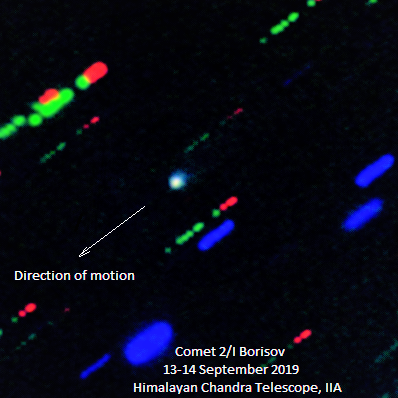Comet C/2019 Q4 (Borisov)
The comet C/2019 Q4 (Borisov), or 2I/Borisov, was discovered in 2019 and gained enormous interest as it turned to be from outside the Solar System (SS). IAU Minor Planet Center wrote: ‘Based on the available observations, the orbit solution for this object has converged to the hyperbolic elements, which would indicate an interstellar origin.’ The other indications are its much higher velocity than usual SS comets, at more than 30 km/sec, and the orbit nearly at a right angle to the ecliptic. This is the first interstellar comet in our times, and the second interstellar object: the first was asteroid Oumuamua that passed through the SS in 2017.
The call for observations went out to everyone all over the world because the more observations are performed, the more precisely the orbit can be determined. We have observed the comet with the HCT on 13th and 14th September with the Himalayan Chandra telescope (HCT), Hanle (MPC code: N50) in 3 filters V, R and I. Each exposure was only 100 sec because it is moving so fast, thus we have combined the exposures in every filter to increase the signal. We show here images in three filters to show the difference in the comet appearance in different bands: in V the tail is longer and straight, while in R and I the tails are shorter and spread out. V image is a stack of 9 frames; R image is a stack of 7,and I image is a stack of 3 frames.
On 13th September, the comet was at 3.389 AU at the start of observations and at 3.388 AU at the end. On 14th it was already at 3.367 AU, covering angular distance of 0.53 deg in just one day. It is interesting to note that, according to other observers as well, the comet colours are the same as our SS comets colours indicating that chemistry is no much different in other solar systems. Our observations (RA, Dec and UTC) are published in the Minor Planet Centre Electronic Circular (M.P.E.C. 2019-T169, issued 2019 October 9).
Observers: Margarita Safonova and C.G. Anaswar. Image manipulations: S. Akaash and Bharat Chandra.

